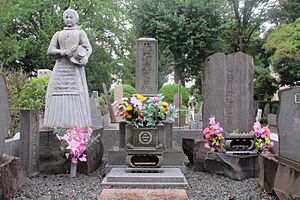Ogino Ginko facts for kids
Quick facts for kids
Ginko Ogino
|
|
|---|---|
 |
|
| Born |
Gin Ogino
April 4, 1851 |
| Died | June 23, 1913 (aged 62) Tokyo, Japan
|
| Nationality | |
| Occupation | Physician |
Ogino Ginko (荻野 吟子, April 4, 1851 – June 23, 1913) was a very important Japanese doctor. She was the first woman in Japan to get a license to practice Western medicine. This means she was the first female doctor in Japan to use modern medical methods.
Contents
Early Life and Big Decisions
Ginko Ogino was born on April 4, 1851, in a place called Tawarase. This area is now part of Kumagaya City in Saitama Prefecture, Japan. Her family was well-respected in their town. Ginko was the youngest of eight children, with two older brothers and five older sisters.
When she was 16, Ginko had an arranged marriage in 1867. She married a man named Kanichiro Inamura. However, she divorced him in 1870. Divorce was very unusual and looked down upon in Japanese society at that time. Her family felt ashamed because of it.
After her divorce, Ginko faced a personal health issue. She felt very uncomfortable being treated by male doctors for this problem. This experience made her decide to become a doctor herself. She wanted to help other women who might feel the same way. She believed that female doctors were greatly needed.
Education and Becoming a Doctor
In 1873, Ginko moved to Tokyo to continue her studies. She went to Yorikuni Inoue's school and graduated with high honors in 1879. This was a big achievement, as only 15 out of 74 female students finished the course.
In 1880, Ginko made history again. She entered the Kojuin medical school, becoming its first female student. She then went to Tokyo Women's Normal School, which is now Ochanomizu University. This was a private medical academy, and all the other students were male.
Despite facing many challenges and prejudices, Ginko worked hard. She graduated in 1882. It took several requests and petitions for her to finally be allowed to take the official medical exam. In 1885, she passed with perfect scores!
Soon after, Ginko opened her own clinic called Ogino Hospital in Yushima. She focused on women's health, helping women with their specific medical needs. In that same year, she became the first officially registered female doctor in Japan.
Later Life and Legacy
Ginko also worked as a doctor at the girls' school of Meiji Gakuin University. She always spoke up for equality between men and women. During this time, she became more involved with the Christian Church. She spent her free time doing volunteer work and helping her church.
In 1890, Ginko married Yukiyoshi Shikata, who was a Christian clergyman. They adopted the child of her husband's sister, who had passed away during childbirth. Ginko had tried to help as an obstetrician during the difficult birth.
In 1894, Ginko moved with her new family to Hokkaidō. There, she continued to run a medical practice, helping people in the community.
After her husband passed away, Ginko returned to Tokyo in 1906. She opened another hospital there. She was very happy to see more and more women becoming doctors and showing interest in women's health. In 1889, she helped start the Woman's Christian Temperance Union (WCTU) and became a professor there. She also became a secretary for an organization that worked to improve women's health.
Ginko Ogino became one of the most important scientific figures of the Meiji period in Japan. She passed away on June 23, 1913, at the age of 63.
Supporting Women in Medicine
Ginko's decision to become a doctor was greatly influenced by her own experiences. She wanted women to have the choice of being treated by other women. This idea came at a time when girls were just starting to speak up for their rights and education.
During the Meiji era, many people still thought that women were not as smart as men. They believed that higher education for women might be harmful. However, many male thinkers actually supported women's independence.
Ginko was fortunate to have support from some of her teachers. One teacher helped her get into a private medical school. After medical school, male students usually took an exam to become licensed doctors. Ginko was the first woman to be allowed to take this important exam.
She succeeded in getting her medical license in 1885 thanks to help from influential male doctors. These men, like Iwamoto Yoshiharu and Inoue, strongly supported women's empowerment. Because of Ginko's success, other women began to follow her path. This helped more women become doctors and showed the growing freedom for Japanese women.
Death
Ginko Ogino died on June 23, 1913, in Tokyo. She was 63 years old. Her body is buried at Zōshigaya Cemetery in Tokyo.
See also
 In Spanish: Ginko Ogino para niños
In Spanish: Ginko Ogino para niños


